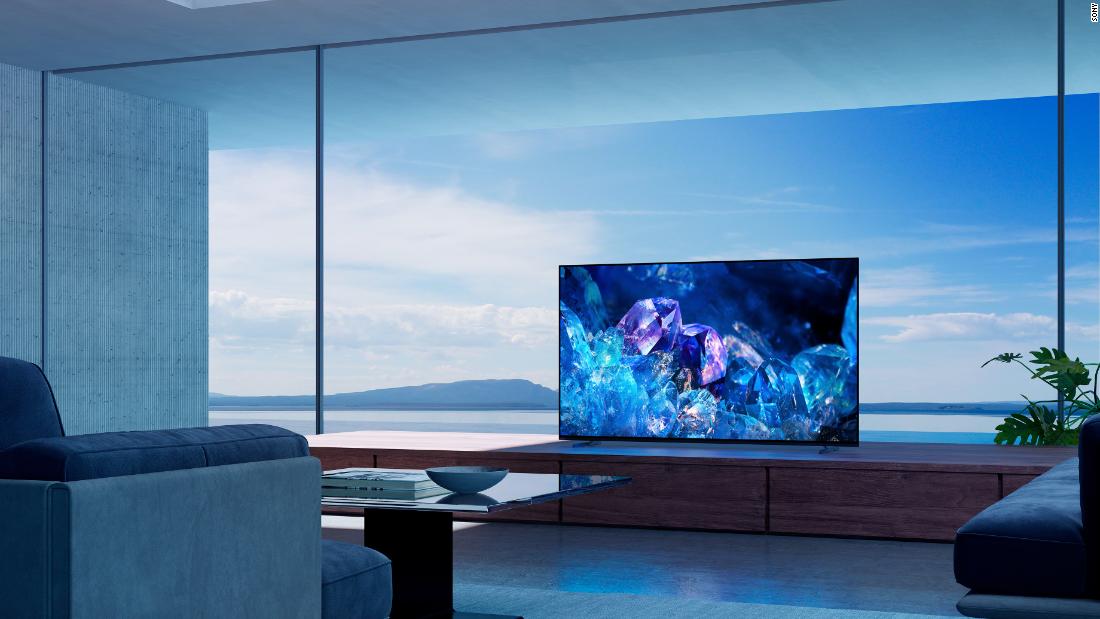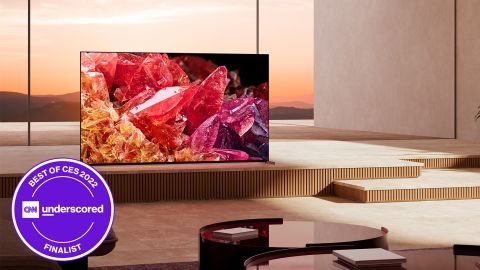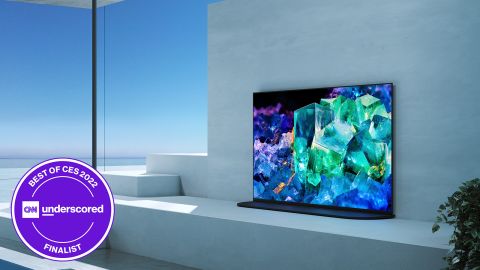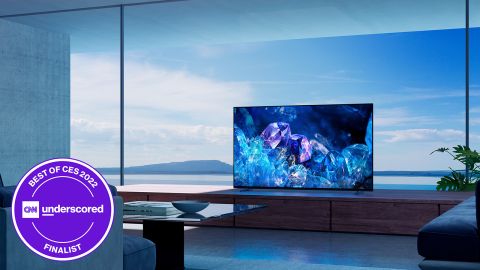
Sony’s 2022 Bravia TV lineup adds Mini LED and OLED

CNN Underscored is bringing you the best of CES 2022 all week — be sure to check out our coverage hub for the biggest tech products worth getting excited about.
Sony is expanding its Bravia TV lineup for CES 2022 by offering Mini LED and Quantum Dot OLED TVs for the first time. It’s a significant shift for the company to offer more models and expand into the Mini LED arena, which is already occupied by players like TCL and Samsung.
The trick here? Well, Sony’s betting big on the Bravia XR Processor — which we took a deep dive into last January — which aims to present killer visuals that don’t mess with how the content is supposed to look.
The 2022 Bravia TVs will be available for purchase in the spring, and for now, we’re breaking down what’s new, specifically with the Mini LED and OLED models. And to better do that, we had an exclusive chat with Tyler Ishida, president of Consumer Business Group, Sony Electronics Inc.

“By having more LEDs in your screen, you can increase brightness and picture quality. That will be the differentiation from the normal LED to Mini LED,” says Ishida, explaining the benefit of Mini LED televisions. And to a degree, it’s making an LED more like an OLED in that the processor can give more detailed instructions to create the best picture quality.
As we’ve seen with other Mini LED models, the result is a TV that can get exceptionally bright and quite vibrant. But these TVs can also deliver better contrast, as there are more controls for which part of the TV gets super bright from LEDs to create the image.
This is made possible by the XR Backlight Master Drive in Sony’s Bravia XR Processor, which essentially directs the LEDs and works to reduce blooming — an effect that occurs when there’s a halo around an exceptionally bright part of the image on a darker background.
Lastly, these new models are still Sony TVs through and through — in that the Bravia XR Processor identifies the focal point of any given image, in the same vein that a human eye detects the main part of an image. The Mini LEDs will ship with a variable refresh rate (that tops out at 120Hz), which should make gamers and live sports fans especially happy by making the action look as smooth as possible. These TVs will feature a Google TV interface, which debuted on Sony TVs with the 2021 line. Regardless of picture resolution, these will upscale content and offer several viewing modes. All of Sony’s 2022 TVs will also support Apple AirPlay 2 out of the box.
Sony’s Mini LED model will arrive in 4K and 8K models:
- Z9K 8K Series: 75-inch and 85-inch
- X95K 4K Series: 65-inch, 75-inch and 85-inch

Sony’s 2021 A90J OLED was quite honestly the best TV we’ve ever tested — with the most dramatic and accurate visuals all housed in an OLED panel that delivered the best brightness we’ve ever seen. But it’s not cheap, and that’s why it resides as our luxury pick for a TV. Now Sony promises an even better OLED by adding Quantum Dots into the mix for a whole new panel that can get much brighter and offers a better range of colors. This, paired with Sony’s processing techniques, could make the A95K the best TV in the business.
Essentially, this panel can still deliver deep blacks for an impressive contrast level but adds in qualities of the Quantum Dot filter and layers for better vibrancy and higher overall brightness. The light essentially gets processed and scattered through the Quantum Dot panel to create the desired image.
Sony promises that even when the panel is fully engaged, the full spectrum of the intended color will be visible. At times OLED panels could skew white a bit when projecting a bright color, so instead of a whitish orange, this panel could deliver pure bright orange, as an example.
All of this comes together for a panel that should best what is our current top pick, Sony’s A90J. It will also support variable refresh rate — like the Mini LEDs — upscale content to 4K, be powered by Google TV and offer some pretty neat designs. The actual mount for the A95K — Sony’s model name for the QD-OLED (Quantum Dot OLED) — will have it lay flat on a surface, protruding with a metal slab flush at the front or the back.

Sony’s 2021 A90J isn’t necessarily disappearing and is becoming the A90K Master Series. There’s a catch here in that the A90K is coming only in 42-inch and 48-inch models, which might make this the perfect small OLED or more likely a perfect choice for gamers. It should also perform exactly the same as the A90J, which would mean that it’s very good.
That same panel is turning into the A80K, Sony’s entry-level OLED available in 55-inch, 65-inch and 77-inch models. This will essentially use the same panel and processor as the A90J but lack the Master Series fine-tuning. It is an excellent example of trickling down more expensive technologies to more affordable models.
“We have actually made the choice of bringing the great elements of A90J to the A80K this year, to give more audiences the experience of a Sony TV,” Ishida explains. It’s a big change for a TV brand that generally only plays in the premium space. And while Sony isn’t yet sharing the prices for the A80K model, we anticipate it will be a competitive offering.
- A95K 4K QD-OLED: 55-inch and 65-inch
- A90K 4K OLED: 42-inch and 48-inch
- A80K 4K OLED: 55-inch, 65-inch and 77-inch
Sony’s premium offerings — including OLEDs and Mini LEDs — feature an improved remote that is not only smaller but also has built-in finder functionality so that you can ping the remote in the event you lose it. It’s similar to how a Bluetooth item tracker — like an AirTag — works, and Ishida even notes that he’s “so surprised we didn’t do this in the past,” as it’s a really useful quality of life improvement for the user.
It’s clear Sony’s looking to offer more choice this year, especially with the introduction of Mini LED alongside OLED. An OLED can deliver an immersive experience in a darker room since the panel can’t get as bright as conventional LED panels. And a Mini LED TV would likely work better in a room with windows that gets brighter since it can get super vibrant. Of course, pricing will be a major factor in terms of determining who these TVs are for, and we’ll be getting that info later this year.
We also asked Ishida to sum up why someone should consider a Sony TV — Mini LED, OLED or LED — over the competition. The main reason would be how these TVs process an image. Ishida notes that the company’s Bravia XR Processor “does make a difference and that’s where we’re going to be focusing on continuously.” That in combination with Sony’s historical knowledge and the ability to work with other divisions — like Sony Pictures — helps the brand to create an image that respects the creator’s intent and can immerse a viewer.
We’re eager to go hands-on with Sony’s new lineup, especially to see the QD-OLEDs and Mini LEDs side by side. Sony’s X95K 4K Mini LED is a finalist in our TV category for Best of CES 2022 for the new controls with this panel type. We’re also naming the A95K QD-OLED a finalist for the new panel technology and the A80K as a finalist for trickling down the features of the top-rated A90J to a hopefully more accessible price point. We’ll be sharing our full finalists later this week, ahead of the top picks in each category.
Stay tuned for hands-on and full reviews of all of Sony’s 2022 Bravia TVs, and click here to see our thoughts on the new Bravia Cam accessory for Sony’s 2022 TVs.
Source: https://www.cnn.com/2022/01/04/cnn-underscored/sony-bravia-qd-oled-tv-ces-2022/index.html?iid=CNNUnderscoredHPcontainer
















